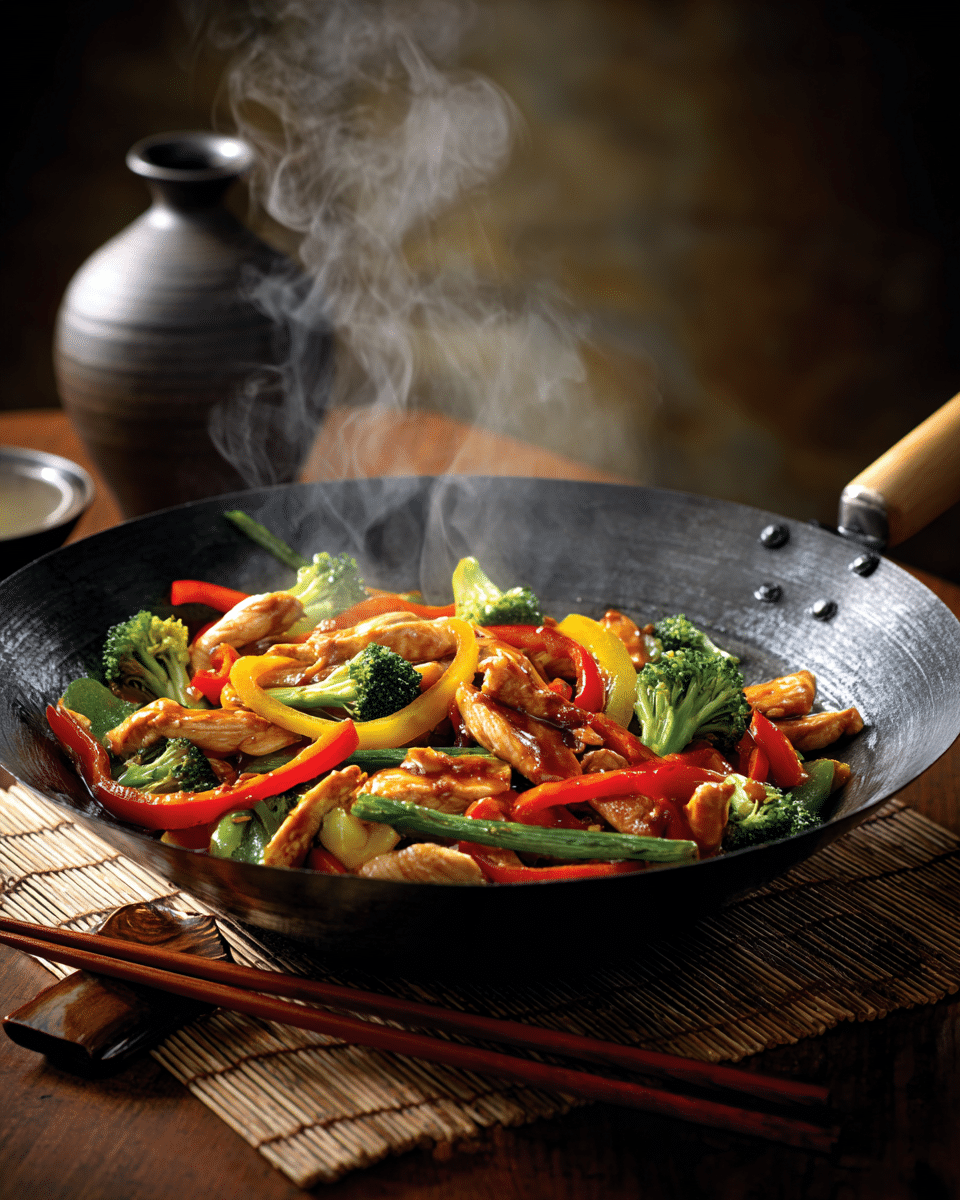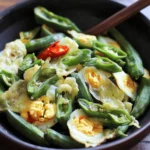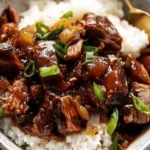This 20-Minute Chicken Stir-Fry is the ultimate solution for busy weeknights when you want something quick, healthy, and packed with flavor. Inspired by Asian takeout classics, it combines tender chicken breast, crisp vegetables, and a savory-sweet stir-fry sauce—all cooked in one skillet. It’s customizable with your favorite veggies and pairs perfectly with steamed rice or noodles for a satisfying meal that’s faster than delivery.
FULL RECIPE
Ingredients
- 1 lb boneless, skinless chicken breasts, thinly sliced
- 2 tablespoons vegetable oil, divided
- 2 cups broccoli florets
- 1 red bell pepper, thinly sliced
- 1 carrot, julienned or thinly sliced
- 3 cloves garlic, minced
- 1 teaspoon fresh ginger, grated (optional)
- 3 tablespoons soy sauce (low-sodium preferred)
- 1 tablespoon oyster sauce
- 1 tablespoon hoisin sauce
- 1 teaspoon sesame oil
- 1 teaspoon cornstarch mixed with 2 tablespoons water
- Salt and pepper, to taste
- Sesame seeds and chopped green onions, for garnish (optional)
Directions
- Heat 1 tablespoon of oil in a large skillet or wok over medium-high heat.
- Add the sliced chicken, season lightly with salt and pepper, and cook for 4–5 minutes until browned and cooked through. Remove from the pan and set aside.
- In the same skillet, add the remaining 1 tablespoon of oil. Toss in the broccoli, red bell pepper, and carrot. Stir-fry for about 4–5 minutes until just tender.
- Add the garlic and ginger (if using), and stir-fry for another 30 seconds until fragrant.
- Return the cooked chicken to the skillet and toss to combine.
- In a small bowl, mix soy sauce, oyster sauce, hoisin sauce, sesame oil, and cornstarch slurry.
- Pour the sauce over the chicken and vegetables. Stir well to coat everything evenly.
- Cook for 1–2 more minutes until the sauce thickens slightly.
- Remove from heat and garnish with sesame seeds and green onions if desired.
- Serve immediately over steamed rice or noodles.
Nutrition Facts
- Calories: 305
- Total Fat: 13g
- Saturated Fat: 2g
- Trans Fat: 0g
- Cholesterol: 75mg
- Sodium: 730mg
- Total Carbohydrates: 17g
- Dietary Fiber: 3g
- Sugars: 7g
- Protein: 32g
- Vitamin A: 60% DV
- Vitamin C: 90% DV
- Calcium: 6% DV
- Iron: 10% DV
Health Benefits of a Balanced Chicken Stir-Fry
This chicken stir-fry delivers a nutritious balance of lean protein, fresh vegetables, and a moderate amount of healthy fats. Chicken breast is an excellent source of low-fat, high-quality protein, which supports muscle repair and satiety. The inclusion of vegetables like broccoli, carrots, and bell peppers boosts the fiber content and provides a rich array of vitamins and antioxidants, such as vitamin A, vitamin C, and beta carotene. The dish is also relatively low in sugar and saturated fat, making it a heart-healthy choice when prepared with minimal oil and a well-balanced sauce.
Flavor Profile and Sauce Components
The sauce is the heart of any stir-fry, and in this recipe, it achieves a perfect harmony of savory, slightly sweet, and umami-rich flavors. Soy sauce provides saltiness and depth, while oyster and hoisin sauces contribute a touch of sweetness and complexity. A dash of sesame oil enhances the dish with its signature toasted aroma, giving the sauce an authentic Asian flavor. The cornstarch slurry helps thicken the sauce, allowing it to cling beautifully to the chicken and vegetables, ensuring each bite is coated in bold, satisfying flavor.
Vegetable Variations and Add-Ins
One of the great strengths of a stir-fry is its adaptability. You can switch out the vegetables based on seasonality or personal preference without compromising the integrity of the dish. Try snap peas, snow peas, zucchini, mushrooms, baby corn, cabbage, or bok choy for variation. Frozen stir-fry vegetable mixes are also a convenient option when fresh produce isn’t available. For added bulk and nutrition, consider tossing in edamame or tofu cubes alongside the chicken. You can even include nuts like cashews or peanuts for a satisfying crunch.
How to Perfectly Cook Chicken for Stir-Fry
To ensure tender and flavorful chicken, it’s important to slice the meat thinly and uniformly so it cooks quickly and evenly. Always preheat the pan before adding the chicken, and avoid overcrowding the skillet—cook in batches if needed to achieve a nice sear. Stir-frying the chicken until just cooked through and then removing it from the pan before adding the vegetables prevents it from becoming dry. Reintroducing the chicken at the end allows it to absorb the sauce and meld with the flavors of the dish without being overcooked.
Best Oils for Stir-Frying
Choosing the right cooking oil is crucial in high-heat stir-frying. Vegetable oil, canola oil, peanut oil, or sunflower oil are excellent options due to their high smoke points and neutral flavors. Sesame oil, while aromatic and flavorful, has a lower smoke point and should be used primarily as a finishing oil to enhance the dish after cooking. Avoid using butter or olive oil, as they burn easily and can impart unwanted flavors. For a healthier alternative, avocado oil is also a good choice due to its high heat tolerance and mild flavor.
Serving Ideas and Meal Pairings
This stir-fry is incredibly versatile and pairs well with a variety of sides. Steamed jasmine or brown rice is a classic accompaniment that soaks up the flavorful sauce. For a low-carb option, consider serving it over cauliflower rice or zucchini noodles. Stir-fried noodles like lo mein, soba, or rice noodles are also excellent choices. To round out the meal, serve with a light miso soup, spring rolls, or a simple cucumber salad. The stir-fry also works well in lettuce wraps or stuffed into pita bread for creative leftovers the next day.
Making It Gluten-Free or Low-Sodium
To make this stir-fry gluten-free, simply use tamari or a certified gluten-free soy sauce in place of regular soy sauce. Double-check labels on oyster and hoisin sauces, as many contain wheat—there are gluten-free versions available in specialty stores. For a lower-sodium version, choose reduced-sodium soy sauce and reduce the amount of sauce overall, enhancing flavor with fresh herbs like cilantro or green onion instead. These easy adjustments can help meet dietary needs without sacrificing taste or texture.
Storing and Reheating Leftovers
Leftover chicken stir-fry stores well and can be enjoyed for up to 3 to 4 days when kept in an airtight container in the refrigerator. For best results, reheat in a skillet over medium heat with a splash of water or broth to revive the sauce without overcooking the chicken. Microwaving is also an option, though the vegetables may soften more than desired. This dish can be prepped ahead of time by slicing the ingredients and mixing the sauce in advance, making it ideal for meal prep or next-day lunches.
Using Stir-Fry for Meal Prep
This 20-minute chicken stir-fry is an excellent choice for meal prep, especially for those looking to maintain a nutritious diet with minimal effort. You can portion the stir-fry into individual containers with rice or noodles for grab-and-go lunches throughout the week. The dish holds its texture well and reheats quickly, making it ideal for busy professionals or students. You can also scale the recipe up easily, doubling the quantity without much added effort. With its balanced mix of protein, vegetables, and complex flavors, it’s a wholesome and satisfying meal to enjoy on repeat.
Advertisement
Conclusion
This quick and flavorful chicken stir-fry is a standout dish that brings together the best of Asian-inspired cooking with the practicality needed for busy lives. Its adaptability, nutritional value, and bold taste make it a favorite for weeknight dinners and meal prep alike. Whether you’re customizing it with seasonal veggies, serving it with your favorite grains, or preparing it ahead for a hectic week, this stir-fry proves that fast food at home can be fresh, healthy, and utterly delicious.






